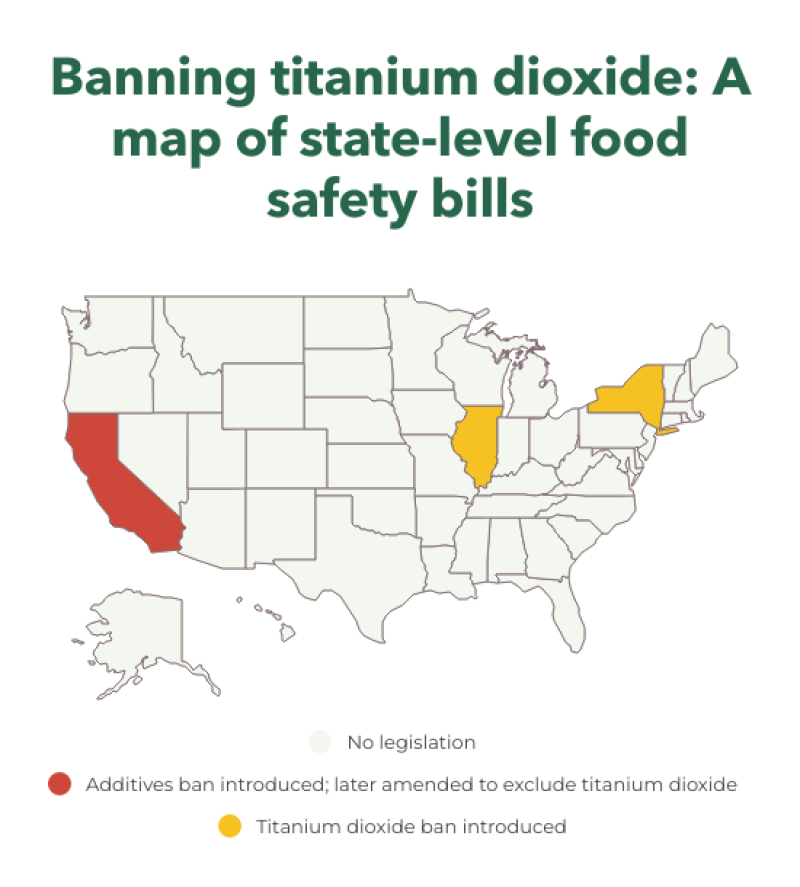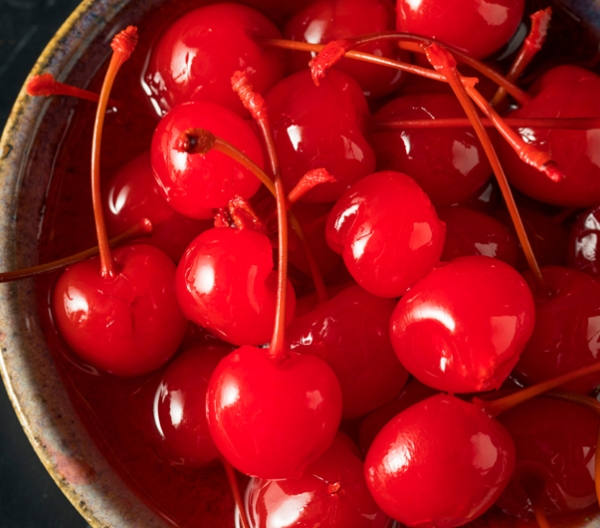Titanium dioxide: Why FDA should ban this harmful additive

Piman Khrutmuang - stock.adobe.com.
Titanium dioxide is a color additive used in food that can potentially accumulate in our bodies. It is associated with health risks such as DNA damage and immune system toxicity. The European Union banned the use of titanium dioxide in foods due to these safety concerns, yet the additive remains legal in the US. CSPI and other public health advocacy organizations petitioned the FDA to ban the chemical in foods in March 2023, but the agency has yet to respond.
What is titanium dioxide?
Titanium dioxide (TiO2) is a chemical that is currently approved for use in the US as a coloring additive in foods, medical products, drugs, and cosmetics. The additive can be found on grocery store shelves in a wide range of food products, including baked goods, chewing gum, chocolate, puddings, hard-shelled candies, frosting, dressings, sauces, and coffee creamers. Titanium dioxide does not have a nutritional or preservative function, but instead is used solely for superficial purposes, adding a white color and brightness to foods and beverages. Many foods that contain titanium dioxide are specifically marketed toward children.
According to a database from the US Department of Agriculture, titanium dioxide is currently used in nearly 13,000 brand-name food products, including Kroger’s Fat Free Half-and-Half, Little Debbie’s Fudge Rounds, Wegmans’ Original Mac ‘n Cheese, Marzetti’s Cream Cheese Fruit Dip, and Campbell’s Healthy Request Chunky Chicken Corn Chowder Soup. Titanium dioxide does not have to be listed by name on ingredient lists—instead, food companies can just call it “artificial color” or other similarly vague terms—meaning 13,000 products is an underestimate.
Why CSPI advises consumers to avoid foods with the additive
A safety evaluation by the European Food Safety Authority (EFSA) found that evidence suggests that when humans ingest food-grade titanium dioxide, small particles of titanium dioxide—or “nanoparticles”—can potentially accumulate in the human body over time and cause genetic damage. In turn, damage to DNA is one way that chemicals can cause cancer and other health problems. Accumulation of titanium dioxide nanoparticles in the body may also damage the immune and nervous systems. (That said, titanium dioxide used in mineral sunscreens isn’t absorbed and is considered safe and effective by the FDA.)
Due to the possible negative health effects of ingesting titanium dioxide nanoparticles, CSPI’s Chemical Cuisine tool currently advises consumers to avoid food products containing this additive. However, some food labels do not directly list titanium dioxide as an ingredient and instead hide the ingredient behind terms like “color added” or “artificial color.” This makes it more difficult for consumers to determine whether titanium dioxide is in a particular product, increasing the need for government action to protect consumers from the additive.
Learn more about titanium dioxide in Chemical Cuisine
The European Union banned titanium dioxide over legitimate health concerns
After EFSA concluded its assessment revealing health concerns in 2021, the European Union banned the use of titanium dioxide in foods in 2022.
Conversely, Health Canada’s Food Directorate chose not to ban titanium dioxide in 2022, although it noted uncertainties in the safety of titanium dioxide. The differences in conclusions between EFSA and Health Canada primarily relate to which studies each agency considered relevant. Health Canada considered studies with food-grade-comparable titanium dioxide to be most relevant, meaning if a study were performed with titanium dioxide nanoparticles alone, they generally did not include it in their safety assessment.
This distinction is critical. One study determined that in some food products, up to 74 percent of the food-grade titanium dioxide particles could be nanoparticles, suggesting that consideration of nanoparticle accumulation and toxicity is critical to understanding titanium dioxide’s health risks. Consequently, EFSA considered studies on titanium dioxide nanoparticles to be relevant for assessing food-grade titanium dioxide.
Despite health concerns, the FDA has failed to ban titanium dioxide
Despite warnings from public health watchdogs and studies identifying dangers associated with titanium dioxide nanoparticles, the FDA still allows the use of titanium dioxide in foods in the US. The FDA approved the use of titanium dioxide in food in 1966. In a brief statement to industry issued in June 2023, the FDA claims it has evaluated EFSA’s opinion and concluded that titanium dioxide is safe, using a rationale similar to Health Canada. Given how short this statement is and the sparse details included, it is unclear how thoroughly the FDA evaluated the evidence in this case.
CSPI and four other food safety and public health advocacy groups petitioned the FDA in March 2023 to revoke approval of titanium dioxide as an additive in food products. The FDA is required to address petitions within 180 days, but the agency has not yet responded.
CSPI will continue to raise public awareness of the health concerns surrounding titanium dioxide and encourage the federal government to reverse its approval of the dangerous additive.
States could also ban harmful food additives
In the absence of federal action, proposals in some states seek to ban titanium dioxide and other dangerous food additives. In 2023, California signed the California Food Safety Act into law, which bans five food additives in California: Red 3, propylparaben, brominated vegetable oil, and potassium bromate. Earlier iterations of the bill also included titanium dioxide, but just before the California Legislature passed the bill, legislators amended it to exclude titanium dioxide from the list of restricted chemicals. While the other four additives will be banned in the state starting in 2027, titanium dioxide remains legal nationwide.
New York State lawmakers followed California’s lead by introducing New York Senate Bill S6055B/Assembly Bill A6424A, a similar piece of legislation that would ban the same five additives as the original California bill (including titanium dioxide), plus two additional chemicals. State-level proposals to ban titanium dioxide do not outlaw any specific food products, but instead prohibit the use of certain additives. Manufacturers would have time to adjust their food product recipes to respond to these new restrictions.

How you can protect yourself from titanium dioxide’s health risks
Although fully addressing titanium dioxide’s dangers will require policy change, you can protect your health and your family in the interim by following CSPI’s recommendation to avoid foods containing titanium dioxide. Be sure to read food labels carefully if you are unsure about whether a particular brand-name product contains titanium dioxide.
You could also help raise awareness of CSPI’s petition asking the FDA to ban titanium dioxide at the federal level. Likewise, you can call on your state and local representatives to push for restrictions on titanium dioxide. Finally, you can support CSPI’s efforts to improve oversight of food additives so we can cultivate a food supply that is safer and more transparent.

Stirring the Pot
Join the fight for safer, healthier food
Sign up to receive action alerts and opportunities to support our work in Stirring the Pot, our monthly newsletter roundup.

